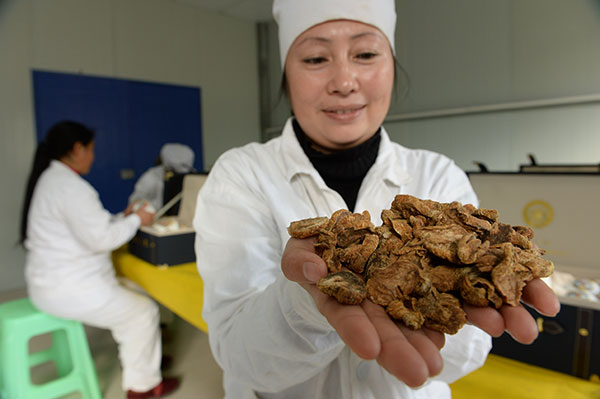 |
|
A worker displays slices of dried root at a factory in Guiyang, Guizhou province, in Nov last year. Yang Ying/Xinhua |
High altitude, high demand, high cost
Maca, a member of the Brassicaceae family, has been cultivated in Peru for more than 2,000 years, where it grows exclusively in the central Andes at an altitude of about 3,000 meters, according to Yang Shengchao, a professor at Yunnan Agriculture University.
Yang said maca's medicinal properties have seen it used as a traditional food supplement for centuries.
The root, which was introduced to China in 2000, is believed to contain significant amounts of amino acids, carbohydrates, vitamins and minerals, natural medicinal and nutritional qualities beneficial to human health, he said.
In 2011, experts from Universidad Peruana Cayetano Heredia in the Peruvian capital Lima, published a research paper that proved maca can treat sexual dysfunction, brittle bones, enlarged prostate glands, memory and learning capabilities. It also protects the skin against the effects of ultraviolet radiation.
Moreover, a 2008 research paper published by scientists from the School of Biomedical and Health Sciences at Victoria University in Melbourne, Australia, proved that maca relieves psychological conditions, including anxiety and depression, and lowers sexual dysfunction in postmenopausal women.
"Black and purple roots are usually priced higher, but our lab analysis didn't find too many distinctions in the nutritional components in different colors," said Dong Wanhong, manager of the processing department at Yancheng Baisuifang, a maca retailer in Lijiang, Yunnan province.
Rather than relying on color, Yang said the quality can only be guaranteed via scientific planting methods that directly influence the number of nutrients in the root.
"Crop rotation is a key factor because it reduces soil erosion and increases soil fertility," he said, adding that farmland on which maca has been cultivated for two years should be sown with buckwheat or tomatoes during the third year to restore lost nutrients.
